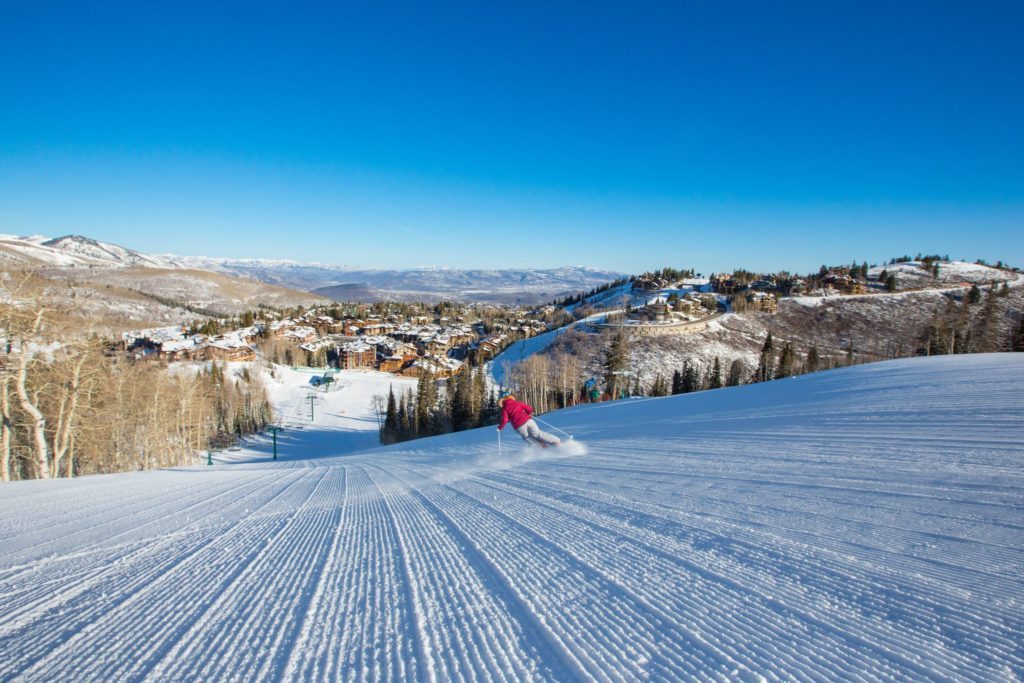The Snow Alchemists
When you tell friends about your Deer Valley ski vacation and before you start explaining the resort famed “corduroy”, nine times out of ten, they’ll ask you: “How was the snow?” Today, I’m spending a few moments with Scott Enos, Deer Valley Resort Snowmaking Manager, one of these experts, with a quarter of a century experience in producing man-made snow that guarantees a unique ski experience.
JF: Before we explore the key role you play at Deer Valley, tell me, why do we need man-made snow in the first place?
Scott Enos: Man-made snow is not necessarily the snow you want to ski on, look at it as a “primer.” It’s a base layer upon which we accumulate natural snow by starting from a safe base, covering rocks, twigs and terrain irregularities. Once this layer is in place, our ski season is secured.
JF: What does it take to make snow?
Scott Enos: It takes lots of water and obviously, huge amounts of electrical power, because our snow guns all run on electricity. So with all that water, compressed air and the right temperature and humidity, you can make snow.
JF: But how do you actually turn water into snow?
Scott Enos: You need a snow gun and we have two types of them. The first type is called “fan gun” and is used on the lower part of the mountain. It has a barrel with a large, 25 HP fan inside; this creates a column of air into which we inject water. To “seed” that water, there’s also a 10 HP compressor that transforms the mixture of air and water into a plume that turns into snow as soon as it hits the frigid air.
JF: What’s your second type of snow gun?
Scott Enos: It’s a compressed air system that directly mixes water and compressed air. We connect it to our slope-side hydrants and both elements are mixed inside a nozzle that blows snow on the ski run.
JF: Are all ski runs receiving the same depth of snow?
Scott Enos: Years of observation and experience, slope grade and traffic patterns define how we lay the snow. Steeper pitches, sun exposure, high skier traffic and terminal areas generally require deeper coverage than average slopes.
JF: What is the warmest temperature at which you can make snow?
Scott Enos: Technically speaking it’s 28 degree Fahrenheit. When we’re talking about snowmaking we refer to “wet-bulb temperature” which indicates the factor of humidity in the air, as opposed to “dry-bulb temperature” which is more like the actual temperature we measure. For instance when the wet-bulb temperature is 28, the dry-bulb temperature could be as high as 36 degrees. This means that high humidity conditions makes snow making less efficient.
JF: Are you saying that the output is greater when the weather is dryer and colder?
Scott Enos: Certainly! Here at Deer Valley we can pump 7,000 gallons of water per minute; which equates to about 10 million gallons per day. As the temperature decreases and the air remains dry, our volume increases to the point that we can’t move the equipment fast enough and have to reduce our water use.
JF: How has technology evolved over the past 25 years?
Scott Enos: Tremendously! Monitoring system used to be non-existent; today, we have multiple weather stations on the mountain that we monitor in real time and integrate automatically with our pumping system. Some of our fan guns are now fully automated and equipped with telemetry that allows us to control them through my office computer. Our new machines are also much more efficient; the new air-water guns have nothing in common with the old ones. Over that quarter-century it’s fair to say that our capacity to make snow has increased one hundred fold!
JF: Early in the season, I see those big mounds of snow that you call “whales”, piled up on some runs, I often wonder “How can the snowmakers tell when they have made enough snow?” How do you measure your output?
Scott Enos: Sorry to disappoint you, but we don’t take any sophisticated measurements; Experience simply tell us “we’ve got enough snow!”
JF: Why do you let these big “whales” sit for some time before spreading them on the trail?
Scott Enos: We always let them sit for a while before we break them; they “cure,” so the excess water contained in them can fully drain out. We want snow that is consistent, without frozen water inside. We let them sit at least a day before the snow cat breaks them up and we’ll let that snow sit for another day. We take the time to make it right!
JF: Let’s talk now about water, your main raw material. Can you tell us where your main storage facilities are on the mountain?
Scott Enos: We have several storage ponds. Three large ones are at Snow Park between the Deer Valley Plaza and our parking lots. Then, on Deer Crest, as you’re skiing down Jordanelle and pass the last bridge, you’ll see into the side of the hill a concrete station that pumps 25 millions gallons of water that we purchase from the Jordanelle Special Service District. This water comes from the Keetley mine before it’s cooled through a treatment plant, as it comes fairly warm from the ground. Finally, for the upper mountain, we have a reservoir that sits at 8,813 feet, by the Homeward Bound run. We buy this water from Park City and it also replenishes itself through the year.
JF: So when environmentalists question the wisdom of using so much water for just making snow, how do you respond?
Scott Enos: We take water that runs in late fall and early winter and that can’t be used for say, agriculture. So, we take that water and conserve it under the form of snow so it can melt later, just like the rest of our mountain snow pack.
JF: Let’s now talk about your people, the ones who make all that snow…
Scott Enos: The snowmakers are an eclectic group of people. There’s 36 guys and girls and me!
JF: Is it all night work?
Scott Enos: More than that, it’s 24 hours a day, seven days a week. The crews work in teams, with a swing shift and a graveyard shift. The shifts start at 1 a.m. and at 1 p.m. They sign up for five days a week, weather permitting, and at any given time, we always have 12 to 14 snowmakers on duty on the mountain from the end of October through the end of January. When we’re done making snow, many crew members will be doing something else. Some are snow groomers, ski instructors, bakers or snow plow drivers, as snow-removal is another task our department handles.
JF: What does it takes to work as a snowmaker?
Scott Enos: This type of work is physically demanding. The hours are long, the work is hard. These people have to deal with all kinds of adverse conditions; in fact, the tougher the conditions, the harder the work. It’s just remarkable that a large core group of people come back to us season after season!
JF: What do you do in summer?
Scott Enos: We prepare for the following snow season. We start implementing our capital improvements that are a yearly occurrence. Deer Valley is a resort that really understands the value of snowmaking and what it means to its guests. We strive yo make our slopes more fun to ski on, more user friendly and there is no end to our commitment to improve our guests’ experience. Good snow year or bad snow year, we keep on upgrading our systems, investing in our infrastructure that grows incrementally year after year.
JF: Since you’ve worked here 25 years, you’ve seen many different winters. Is there any relationship between natural snow and the quality of skiing?
Scott Enos: If you want to come out and ski the kind of groomed runs Deer Valley is famous for, even if it’s not a snow record breaking year, you’ll end up having a wonderful time. For instance, just now, the mountain is as good as it ever gets. We may not have knee-deep powder today, but it’s going to come soon anyway. I have a very good feeling about that!









 The Official Blog of Deer Valley Resort
The Official Blog of Deer Valley Resort



Hi. What an awesome resort! Do you still have your SM pump station at the base area by the lakes and did it get re-built?
Thanks